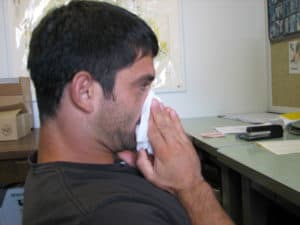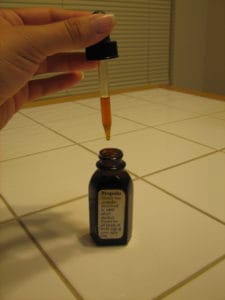
Poor Mike isn’t feeling so well this week. He likely has a cold. But on the positive side he can turn to our beloved bees for a bit of help. People all over the world use a substance bees collect to help treat colds, coughs, and general icky-ness: propolis. Some trees and plants excrete resins to protect their growing buds and wounds from getting infected with bacteria, fungi, and viruses and from insect invaders. Bees visit these plants, collect the resins on their back legs like pollen, and bring it back to the hive. Resins are really sticky, so other bees need to help the bee remove the resins from her legs. Bees will only forage for resin in the afternoon when it is warm and the resin more pliable. The bees put the resins, now called propolis, on any uneven surface like the edges of the frames of comb and between boxes. Propolis is sometimes known as the “bane of beekeepers” or “bee glue” since it makes all the frames and boxes stick together and the colony harder to look through. Bees will also use propolis to close up drafty areas or even embalm intruders like mice at are too large to remove.

The tree resins are produced by the tree for their anti-microbial properties. One example of the properties of propolis comes from a student in a medical lab at the University of Minnesota. She was feeling under the weather, so she purchased some propolis at a farmers market. The lab she was in was working on HIV. The idea come to her to plate propolis along with HIV to see if it prevents the growth of the virus. And it did! Propolis is very complex chemically, so someone needs to identify the active chemicals before further research in the medical community can really take off. But Mike Wilson at the U of MN is working on it now.
As a beekeeper, you can take advantage of the anti-microbial properties of propolis by making a tincture to use if you start to feel ill. Of course, there is no guarantee that it will work for you, but I like to use it.
Adapting from Gary Reuter’s recipe:
Step 1: Collect propolis from a colony. Scrape from boxes and frames or use a propolis trap. Avoid collecting bee parts, wood, paint, or other random bits.

Step 2: Collect 100g of propolis (0.22 lbs or 3.5 oz) and 276 ml (9.3 oz or 1 cup+ 3 tbsp) 70% ethyl alcohol (like everclear or grain alcohol). If you plan to take the tincture orally, then use an alcohol that is same to consume. And, obviously, follow the rules when using alcohol.
Step 3: Mix well and keep out of the light. Mix every 3-4 days for 2 weeks.
Step 4: Strain. Coffee filters work best, but I have used clean pantyhose too.
Step 5: Use. It has a pretty strong flavor, so I like to put a few drops in tea or hot water. I also sometimes put it directly in the back of my throat. Use precaution since some people do have allergies to propolis. Also, it is really sticky and hard to clean when spilled. The only thing that seems to get it out is alcohol.
In addition to the tincture, I have seen people just chew/suck on pieces of propolis straight out of the hive. Just watch out for it sticking to your teeth.
Next week: propolis and bee health